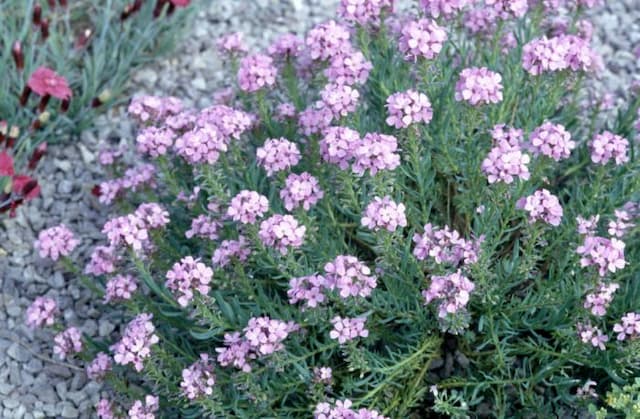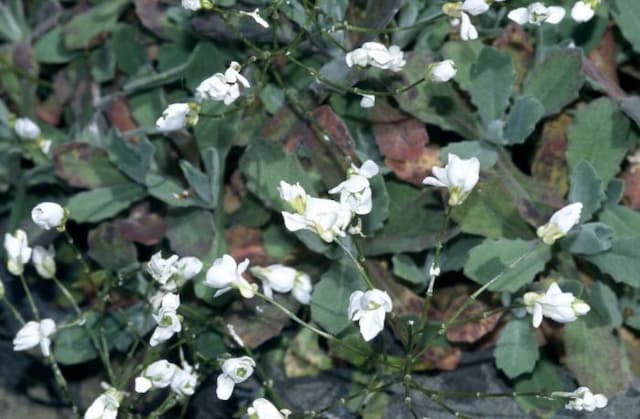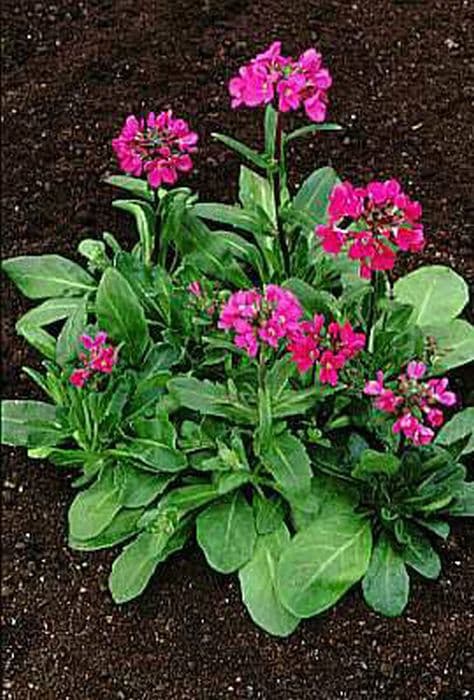Radish 'Scarlet Globe' Raphanus sativus 'Scarlet Globe'

ABOUT
'Scarlet Globe' has leaves about 15cm high and round roots with red skin and crisp white flesh with a mild flavour. Radishes, Raphanus sativus, are annuals or biennials which germinate fast and grow fast, with lobed, dark green leaves to about 15-20cm high, and succulent, sharp-tasting edible enlarged taproots which can be harvested about four weeks after sowing, and can be round, tapering, or cylindrical, and have red, white, green, yellow, purple, or black skin, while the flesh is usually white but may be red or purple; if plants are left long enough, for example when grown as a cover crop or green manure, to grow to about 90cm then they can produce white or pale lilac flowers which provide both nectar and pollen for bees.
About this plant
 Names
NamesSynonyms
Scarlet Globe Radish, Cherry Belle Radish, Red Radish.
Common names
Raphanus sativus var. radicula Pers., Raphanus sativus var. sativus.
 Characteristics
CharacteristicsLife cycle
Annuals
Foliage type
Deciduous
Color of leaves
Green
Flower color
Varies
Height
6 inches (15 cm)
Spread
6 inches (15 cm)
Plant type
Herb
Hardiness zones
2
Native area
Eurasia
Benefits
 General Benefits
General Benefits- Easy to Grow: Raphanus sativus 'Scarlet Globe', commonly known as radish, is easy to cultivate and grows quickly, making it ideal for beginner gardeners.
- Nutritious: Radishes are a good source of vitamin C and minerals, contributing to a healthy diet.
- Soil Health: Radishes can help improve soil health as their roots loosen compact soil, allowing better water infiltration and aeration.
- Companion Planting: Radishes can be beneficial in companion planting as they may deter certain pests when planted alongside other crops.
- Edible Parts: Both the roots and the leaves of radishes are edible, making them a versatile vegetable in culinary use.
- Fast Harvest: Radishes have a short growth cycle, often ready to harvest in as little as three to four weeks, providing quick rewards for the gardener.
- Culinary Versatility: Radishes add a crisp texture and peppery flavor to salads, sandwiches, and other dishes, enhancing culinary creations.
 Medical Properties
Medical Properties- Diuretic Effect: Radish (Raphanus sativus 'Scarlet Globe') may promote increased urine production, potentially supporting kidney health and urinary tract function.
- Digestive Aid: The plant is known to stimulate digestion and relieve constipation due to its fiber content and potentially due to certain enzymes.
- Antiscorbutic: Rich in Vitamin C, radish can help prevent and treat scurvy, a disorder caused by Vitamin C deficiency.
- Antifungal Properties: Radish seeds are believed to possess antifungal properties, which may help protect against fungal infections.
 Air-purifying Qualities
Air-purifying QualitiesThis plant is not specifically known for air purifying qualities.
 Other Uses
Other Uses- Raphanus sativus 'Scarlet Globe', commonly known as radish, can be used to carve intricate designs for food presentation, utilizing its crisp texture and vibrant color.
- The juice from radishes can be used as a natural dye for fabrics and Easter eggs, giving a delicate pink hue.
- Radish leaves can be used to make a pesto, offering a peppery twist to the traditional basil-based sauce.
- The seeds of the radish can be sprouted to create a nutritious garnish rich in vitamins and minerals.
- Radish greens can be added to compost as they decompose quickly, contributing to the production of rich, organic soil.
- Radish peels can be salted and pickled as a unique side dish or condiment.
- The sturdy nature of radishes makes them suitable for use as stamps in children's crafts, dipped in paint to make patterns.
- Dried and crushed radish seeds can be used as a natural abrasive in homemade cleaners.
- Small radish globes can serve as an organic alternative to marbles in games or as decorative elements in floral arrangements.
- When hollowed out, radishes can serve as tiny containers for serving single-bite appetizers or condiments.
Interesting Facts
 Feng Shui
Feng ShuiThe Radish is not used in Feng Shui practice.
 Zodiac Sign Compitability
Zodiac Sign CompitabilityThe Radish is not used in astrology practice.
 Plant Symbolism
Plant Symbolism- Health: The radish is often associated with good health and vitality due to its rich nutrient content and medicinal properties.
- Prosperity: In some cultures, radishes symbolize prosperity and abundance, as they can be sown and harvested quickly.
- Protection: Radishes have been thought to offer protection against evil spirits and negative energies, especially during celebrations like Osechi at Japanese New Year.
- New Beginnings: As radishes are one of the first vegetables to be harvested in spring, they symbolize new beginnings and renewal.
- Passion: The bright red color of the 'Scarlet Globe' radish is sometimes associated with intense emotions and passion, reflecting its vivid hue.
 Water
WaterRadishes require consistent moisture, so water the 'Scarlet Globe' radish gently to avoid washing away the seeds or seedlings. Water them with 1-2 inches of water weekly, although this may vary depending on soil conditions and climate. It's best to water the plants in the morning to allow leaves to dry out during the day and reduce the risk of leaf diseases. Ensure that the soil is moist but not waterlogged, as radishes can rot in overly saturated soil. During periods of dry weather, you may need to water radishes more frequently to maintain the necessary moisture levels.
 Light
LightThe 'Scarlet Globe' radish thrives in full sunlight, which means it needs at least six hours of direct sunlight each day. Place the radishes in a spot where they receive ample sunlight without being shaded by taller plants. Full sunlight will ensure healthy growth and optimal development of the radish bulbs.
 Temperature
TemperatureThe 'Scarlet Globe' radish grows best in cooler temperatures, with an ideal range of 50°F to 65°F. These radishes can survive temperatures as low as 40°F and as high as 85°F but perform best within the cool to mild range. To ensure robust growth and a good crop, avoid extreme heat or cold.
 Pruning
PruningPruning is not typically required for 'Scarlet Globe' radishes as they are harvested before they reach a size that would necessitate trimming. The focus should be on thinning seedlings early in the growing process to allow for proper bulb development. Thin radishes to approximately an inch apart when seedlings are a few inches tall to ensure adequate space for growth.
 Cleaning
CleaningNot needed
 Soil
SoilScarlet Globe radishes require a soil mix that drains well and is rich in organic matter. A mix of garden soil, compost, and perlite or sand works well for these radishes. They prefer a slightly acidic to neutral pH between 6.0 to 7.0 for optimal growth.
 Repotting
RepottingThe Scarlet Globe radish, commonly referred to as radish, does not require repotting as it is an annual vegetable grown from seed and harvested before it would need repotting.
 Humidity & Misting
Humidity & MistingRadishes like the Scarlet Globe variety prefer average ambient humidity and do not require specific humidity conditions to thrive, as long as soil moisture levels are maintained through regular watering.
 Suitable locations
Suitable locationsIndoor
Grow radishes in deep pots with ample light.
Outdoor
Plant in well-drained soil with full sun exposure.
Hardiness zone
2-11 USDA
 Life cycle
Life cycleThe life of the 'Scarlet Globe' radish begins with seed germination, which occurs once the seed is exposed to moisture and the right temperature, typically in spring. This is followed by the seeding stage, where the radish starts to grow its first leaves, known as cotyledons, that push through the soil surface. Once true leaves develop, the plant enters the vegetative growth stage, focusing on developing its foliage and root system, with the unique radish bulb taking shape underground. As the plant matures, it reaches the flowering stage, where it produces small flowers that eventually lead to pollination and seed formation if not harvested earlier. If left unharvested, the plant will complete its life cycle by producing seeds that can be dispensed into the soil, ready to grow a new generation of radish plants once conditions become favorable. The radish is considered a fast-growing plant, often harvested for its edible root within three to four weeks after germination, or left to produce seeds and naturally complete its life cycle over several months.
 Propogation
PropogationPropogation time
Spring
The Raphanus sativus 'Scarlet Globe', commonly known as radish, is typically propagated through seed. The optimal time for sowing radish seeds directly in the garden is in the early spring as soon as the soil can be worked. The seeds should be planted about 1/2 inch deep with a spacing of 1 inch apart in rows that are 12 inches apart. The seeds usually germinate within a few days to a week, depending on soil temperature and moisture conditions. As they grow, thin the seedlings to about 2 inches apart to give each radish enough space to develop. This straightforward process makes seed propagation by far the most popular and effective method for growing radishes.






![Aubrieta [Axcent Burgundy]](/_next/image?url=https%3A%2F%2Fplants-admin.emdemapps.com%2Fimages%2Fplants%2F%2Fimages%2F604b5b7b548d8.png&w=640&q=75)


